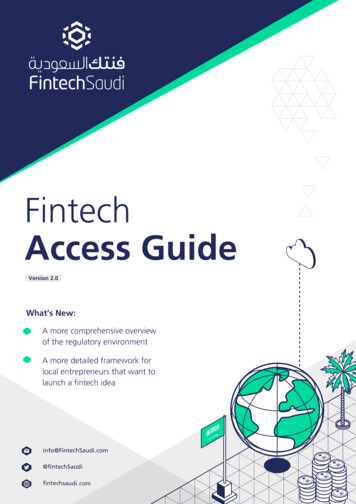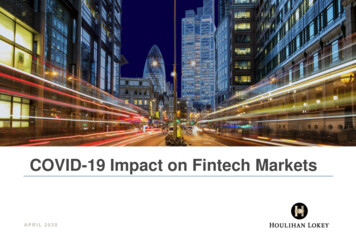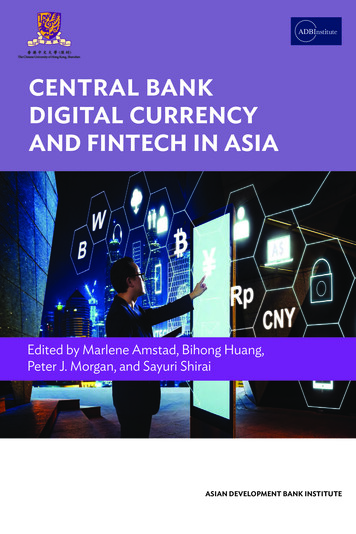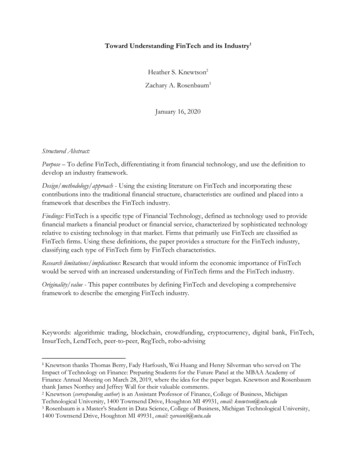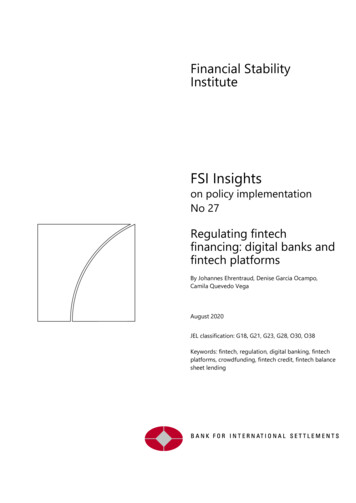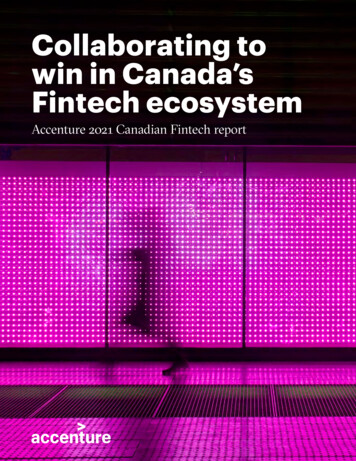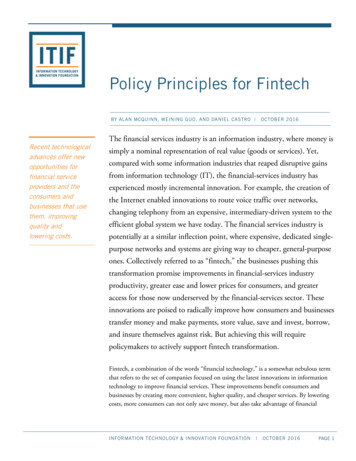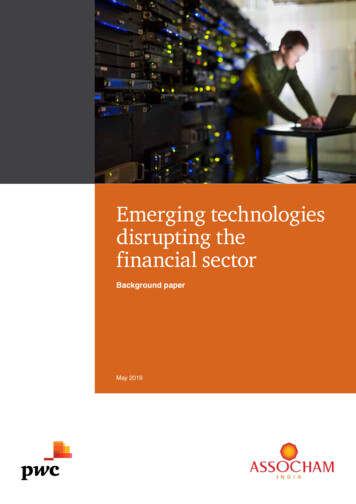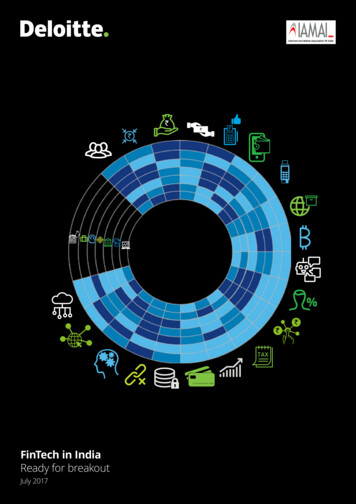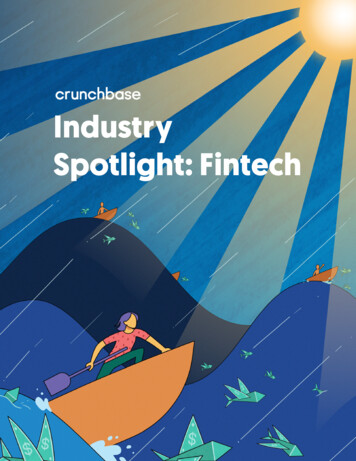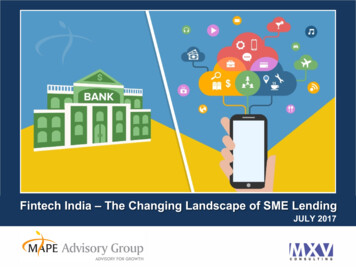
Transcription
Fintech India – The Changing Landscape of SME LendingJULY 2017
PREFACEAs the proverb goes, “every oak must be an acorn”.Small and Medium Enterprises (SMEs) are the engine that drives the global economy, typically contributing more than a third ofthe GDP and about half of all employment. India has more than 50 Mn SMEs, accounting for 38% of GDP.Funding has always been a constraint to the growth of SMEs. Smaller entities often do not have the credentials to avail fundingfrom banks or other formal lenders. Even where credit is available, they often have to go through cumbersome processes andpay exorbitant fees – impacting their competitiveness and growth prospects. It is not unusual for a bank to take a few months toapprove an SME loan. In the western world, the median difference between credit rates to large and small borrowers is almost2%. In Spain, an SME may end up paying a bank 10% for a loan – at a time when the bank’s own cost of funds is close to zero.The situation has worsened post 2008. Despite the overall improvement in global liquidity, SMEs continue to struggle. In theUS, small business credit from banks decreased 20% between 2008 and 2012. In India, barely 10% of small organisationshave access to formal credit. Post-demonetisation, many SMEs have had their strength tested. Building a formal credithistory takes time; many of these enterprises may not last that long.All of this, of course, presents a large opportunity. Even 5% of the unmet SME lending requirements in India could be a 15 Bnopportunity by 2020. The system has the liquidity – but banks do not have the processes or risk management framework toenable lending to these firms. This is where alternate lenders come in.STRICTLY PRIVATE AND CONFIDENTIAL2
PREFACEOver the last decade, non-traditional (or alternate) lenders have entered the SME lending space in numbers. These arechildren of a digital world – using data and digital processes to transform the lending space. They work with new-economypartners, use non-traditional data sources (including daily POS collections and social network scores), develop new creditrating algorithms (with significantly higher approval ratings compared to banks), have built smoother straight-through digitalprocesses (loan approvals in minutes) and have made innovations in the collections process that make them attractive toborrowers. Such lenders have also displayed the ability to scale up and improve their economics on a sustained basis.Several marquis investors have supported the segment.Unlike some other sectors, the incumbents have not pretended to be inert. Banks have made several attempts to address theirshortcomings. The Bank of China has created a credit factory to speed-up SME loans (though they still have four layers ofapprovals). Many traditional financial services organisations are partnering with Fintech start-ups in order to tap into theopportunity and also make sure they have an innovation ecosystem they can learn from. Bank of Baroda, for instance, hasrecently announced tie-ups with five Indian Fintech companies.All of this makes alternate lending a fascinating space for investors. The opportunity is a blue-ocean and new business modelsare being built every day. For an innovator, this is a great place to be.Jacob MathewAmit GargCo-Founder, MAPEFounder, MXV ConsultingSTRICTLY PRIVATE AND CONFIDENTIAL3
CONTENTSThe opportunity in SME lending1The Fintech Revolution: Rise of the alternate lenders2The future of SME lending3Funding Ecosystem4STRICTLY PRIVATE AND CONFIDENTIAL4
SMEs MAKE A SIGNIFICANT CONTRIBUTION TO THE WORLD’S GDPContribution of the SME sector to GDP46%60%38%Note: Definition of SME differs between countriesSource: Literature reviewSTRICTLY PRIVATE AND CONFIDENTIAL5
FUNDING FOR SMES IS A GLOBAL OPPORTUNITY 2.38Tn40%Completely unserved MSMEs indeveloping countriesGlobal demand forSME credit50%44%SMEs who do not have aloan overdraft 75%-20%SMEs who arefinancially constrainedIn the US, percentage of SMEswho did not receive any ofthe bank credit they applied forChange in small businessloans in the US between2008 and 2012STRICTLY PRIVATE AND CONFIDENTIAL6
THERE ARE MORE THAN 50 MILLION SMEs IN INDIAIn 2013-14, SMEs absorbed 44% of new entrants into the labour force in IndiaCAGRSMEEmployment(Lakh -0808-0909-1010-11805No. of SME(Lakh 16P16-17P17-18P18-19P19-20PHowever the gap to other EMs highlights the potential to grow employee contribution to ussiaINDIA15%ArgentinaSME % of EmploymentSTRICTLY PRIVATE AND CONFIDENTIAL7
SMES NEED FUNDING FOR VARIED APPLICATIONS% of Surveyed SME Respondents on Application of Loan Capital53%42%33%29%13%11%Maintaincash flowReserve /CushionInventoryInvestment inequipmentDebtrepaymentReal estatestructuringSource: HBSSTRICTLY PRIVATE AND CONFIDENTIAL8
GLOBALLY, SMES HAVE TROUBLE RAISING FUNDSSMEs with access to credit12%11%30%9%Note: Definition of SME differs between countries.Source: IFCSTRICTLY PRIVATE AND CONFIDENTIAL9
FINANCING CONSTRAINTS A SIGNIFICANT HURDLE TO SCALE UPHuge demand-supply gap in SME financing19.0Traditional banks are generally unwilling to make smallticket loans to these micro and small enterprises due to theperceived risk of such businesses especially without someform of collateralapINR Trillion32.5Microfinance institutions have been able to successfullyprovide small uncollateralized loans to individuals andcommunity groups however, based on regulations in place,microfinance loans are capped at Rs alDemneandur1.9Further exacerbating the problems faced by SMEs Stretched receivables when dealing with larger customers High inventory carrying costs in the manufacturing sector High working capital requirements & limited expansion ability Stringent collateral requirements Limited access to equity capitalResulting in a scarcity of adequate capital at a reasonable costSource: IIBF, IFCThat traditional institutions aren’t able to bridgeInformal lending through local money lenders is available,but the annualized interest rates charged can be as high as80%-100%Due to a combination of constraintsSmall ticketsizes 8%Others 6%Lack ofexperience,36%Poorfinancials,24%Lack of collateralsand infrastructure, 26%STRICTLY PRIVATE AND CONFIDENTIAL10
THE ASSESSMENT PROCESS IS TOUGHER ON SMESDebt is the primary financingoption for SMEsSMEs are inadequately preparedto apply for creditCost of capital is higher becauseof difficulty in assessing riskaccuratelySMEs require flexibility inpayment options SMEs have had limited success with capital market floats, with only 143 IPOsthrough the BSE SME platform since 2011 Record-keeping at smaller entities is less rigorous, resulting in fragmented data Financial literacy is low among SMEs, and they are either not aware of optionsavailable for credit, or are unable to establish and state the case for loans Standard bank tools fail to assess credit risk using the fragmented data from SMEs Rating Agencies like SMERA (SME Rating Agency) provide limited coverage of thesegment – SMERA has rated about 43,000 entities, or less than 0.1% of all SMEs Income volatility is higher for SMEs, and hence fixed monthly payments may notalways work for themSource: MXV Interviews, Literature ReviewSTRICTLY PRIVATE AND CONFIDENTIAL11
EVEN WHEN FUNDING IS AVAILABLE, COST TO SMES CAN BE HIGHEXAMPLE: SPAINTotal cost paid by SMEs for their line of credit (basis points)2101,000130200Borrowing rates forbanks in Spain areclose to 0%, butSMEs pay close to10%for credit460Published ce:INBONISSTRICTLY PRIVATE AND CONFIDENTIAL12
SEVERAL SME CLUSTERS COULD BE ATTRACTIVEAgriculture / foodprocessingFood products andbeverages account for19% of MSME output;employing 6.3 MnManufacturingAgricultural /commercialequipments leasingCommercial leasingaccounts for 25% ofall leasing in IndiaVehicle fortransport /logisticsTextile andapparels aloneemploys almost10 Mn peopleSmall fleet ownersaccount for over 70%of the marketEducation andallied institutionsTravel andtourismThe segmentemploys 2.7 MnpeopleExpansion of e-visascheme is expectedto double touristinflowTradersRetail has 14 Mnenterprises and 25Mn employeesHospitalityThere are 3.4 Mnpeople employedin 1.3 Mn hotelsand restaurantsStart-upsThere is expected a3x jump in Start-upsin India by 2020Source: Ministry of MSME, NSDC, Assocham, Ministry of External Affairs, MXV InterviewsSTRICTLY PRIVATE AND CONFIDENTIAL13
THIS COULD YIELD A 15BN OPPORTUNITY BY 2020Projection of AUM under Fintech companies in India (Rs. Crores/year)1,00,634 This scenarioenvisagesa 5% share forFintech players inSME lendingin 2020Current unmet need estimatedat 300Bn59,196 In 2015 in the US,Alternate Lendersoriginated about 4%of loans to smallbusinesses, which isexpected to increaseto 20% by Source: MXV Analysis BI Intelligence, Interviews, Literature ReviewSTRICTLY PRIVATE AND CONFIDENTIAL14
CONTENTSThe opportunity in SME lending1The Fintech Revolution: Rise of the alternate lenders2The future of SME lending3Funding Ecosystem4STRICTLY PRIVATE AND CONFIDENTIAL15
ALTERNATE LENDERS HAVE EVOLVED ALONGDIFFERENT PATHS IN THE US AND CHINA Emergence of digital intermediaries and cloud enabled enterprise solutionsThese new platforms often have greater visibility into business performance than banks Availability and Monetisation of Digital FootprintsExplosion in mobile penetration and advent of big data leading to emergence of “non-traditional” data points Shift in preferencesNew customers no longer feel the need to physically interact with the service provider at a branchThis has created an opportunity for start-ups to attack and win share from banks in the SME lending space In the US, a variety of models have emerged, notably,peer to peer models where individuals fund businessesrequiring loans Alternate lenders initially targeted a narrow segment ofSMEs and focused on a smaller set of services Chinese SME fintech solutions emerged from digitalintermediaries SME lending often formed a part of a broader solutionprovided by the parent organization, e.g; digital bankWeBank from Tencent and lending service Ant Creditfrom the Alibaba groupSource: MXV Research, Literature ReviewSTRICTLY PRIVATE AND CONFIDENTIAL16
MORE THAN 300 ALTERNATE LENDING COMPANIESFOUNDED EVERY YEARNumber of Alternate Lending CompaniesFounded (Global)Number of Alternate Lending CompaniesFounded (India)416 13 Bn in funding 227 Mn in funding373 452 funding rounds88 43 funding rounds269611443011067201061201120122013201420159M 201681010102010201120122013201420152016India has the 4th highest number of start-upsOthers, 126Australia,39South Africa, 41USA, 485India, 128Source: TracxnUK, 180China, 189STRICTLY PRIVATE AND CONFIDENTIAL17
SME LENDING IS BEING TRANSFORMEDUse Of Alternate DataSources & AutomatedRisk AssessmentIncreased Accessibility& TransparencyImprovedExperienceCredit Score95Innovation InCollectionsDaily Sales Lender3rd PartyVerified DataTAXInvestors Several data points aredrawn into the lendingplatform‘s automatedunderwritingmechanism where analgorithmassesses credit riskBorrowers In marketplaces,lenders and borrowerschoose each other Investors benefit fromdiversifying risk acrossborrowers Borrowers are able toaccess unsecuredloans, quicker For the borrower, theprocess of applying issimplified, whiledisbursement andpayment experiencesare improvedLenderDailyRemittance SMEs can repay aportion of the loanadvance as a % oftransactions madethat day For the lender, the datais 3rd party verified For the lender, the datais 3rd party verifiedSource: Interviews, MXV ResearchSTRICTLY PRIVATE AND CONFIDENTIAL18
USE OF SMARTER DATA LEADS TO LEANER DOCUMENTATIONREQUIREMENTSTraditional Lenders Data Rating agencies likeSMERA have limiteddata on SMEs Traditional documents suchas balancesheet may not be availableAlternate Lenders DataAlternate DataNon-traditionaldocuments areconsideredMore attributesAlternate lenders are alsolooking at new attributes suchas reputation on social networksMore DataThrough tie-ups withintermediaries, alternatelenders now have moredata pointsTraditional Lenders DocumentationAlternate Lenders DocumentationPersonal IT returns for 2 years Assets & Liabilities Statements Personal bank statement for previous 12 monthsBusiness IT returns for 2 years (business) Balance sheet – 2 years VAT/Sales tax return for 2 year Company bank statement for previous 12 months Supporting documents such as invoice copy,receipts against payments, references Cancelled cheque (for account details)Collateral Original title deed & prior deeds for collateral Land & building tax receipts Possession certificate PDC (personal & business)Source: Interviews, MXV Research, Literature ReviewSTRICTLY PRIVATE AND CONFIDENTIAL19
ADVANCED ANALYTICS HAS HELPED BRIDGE A RATING GAPMODELRISK ASSESSMENTTRADITIONALTraditionally risk modeling used to be thepreserve of large financial institutionsOnly a small set of SMEs has been rated by creditrating agencies Many have been excluded on aprima-facie basisEntrenched requirements and constraintsleading to static modelsENABLERSCloud based infrastructures, more data and widedissemination of modeling techniques have allowedalternate lenders to differentiate on the quality of riskassessmentAbility to isolate specific risks leads from having accessto more granular and real-time data which givetraditional “thin-file” applicants a better chance atavailing affordable creditALTERNATENewer risk models are dynamic and adopt machinelearning to become smarter which is a significantadvantage over traditional models which often requireda change in processes and regulations which was moretime consuming and left many out of reach of creditAnalytics and newer risk models being developed alsogive lenders the ability to better securitize their loanswith low-risk bundlingSource: Interviews, MXV Research, Literature ReviewSTRICTLY PRIVATE AND CONFIDENTIAL20
THE DIGITAL ECOSYSTEM IS RIPEE-commerceTransport/logisticsPayment processorsB2B market placesHospitality and tourismEnterprise solution providers These partners provide alternate lenders with a captive market and better data for risk assessment The lending platforms help these companies expand their market by funding partner SMEsSource: Interviews, MXV Research, Literature ReviewSTRICTLY PRIVATE AND CONFIDENTIAL21
DIGITAL INTERMEDIARIES PROVIDE ‘DEEPER DATA’ FORRISK ASSESSMENTWant more sellers / taxi drivers on their platform, andthe sellers to offer more stock for saleRequire funds for working capital in case ofe-commerce seller, or for the purchase of car incase of taxi operatorsDigital intermediary SME E-commerce sellers Drivers on taxi aggregatorsRe-payments could be directly fromthe intermediary through deductionLending Start-upThe digital intermediaries providedata on past performance andexpected performance of SMEpartnersAlternate lenders use the datafor risk assessment and providefunding to the SMEsWant more ‘quality’ applicantsfor loans, and better data for riskassessmentSource: Interviews, MXV Research, Literature ReviewSTRICTLY PRIVATE AND CONFIDENTIAL22
INCREASED TRANSPARENCY MAKE THESE MODELSATTRACTIVE TO LENDERS AND BORROWERSBanksAlternatelendersIncreased access through long tail targetingAlternate lenders have provided access to SMEsbeyond those targeted by BanksIncreased availability of fundsMarketplaces tap individuals for funds, letting thempartly fund a borrower, or fund multiple borrowers,spreading the risk%?Rates and chargesBorrowers get clarity on the rates and on pre-payment;while the lenders get to set their desired risk group andlending rateVisibility on the process and flexibilityBorrowers get better view of the state of the process,allowing them to shop elsewhere if the loan is beingdeclinedSource: Interviews, MXV ResearchSTRICTLY PRIVATE AND CONFIDENTIAL23
WITH SUPPLEMENTAL DATA, ALTERNATIVE LENDERS SEEMABLE TO TAKE MORE RISKApproval Rate by Lender Type (US, 2014)64%51%43%19%AlternativeCommunity BanksCredit UnionsBig BanksSource: HBSSTRICTLY PRIVATE AND CONFIDENTIAL24
THE LENDING EXPERIENCE HAS IMPROVEDHandholding & supportInformal and unregisteredSMEs get support through astructured process that helpsthem establish their caseApplicationFaster turnaroundBetter risk assessment, anda simplified process with fewerphysical touch points helpscomplete the cycle fasterVerified dataLenders get assurance ofbetter data, and of moreaccurate risk assessmentInternal evaluationTrackingReal-time tracking and updatesallow lenders to monitor borrowers’performance and to proactivelymanage riskOnline process ande-signingOnline process, acceptingscanned documents, andallowing e-signing / e-KYCreduces cycletimeSigning and closureLesser frustrationLesser frustration fromlate-stage rejectionSource: Interviews, MXV Research, Literature ReviewSTRICTLY PRIVATE AND CONFIDENTIAL25
REDUCING PHYSICAL TOUCH POINTS AND SIMPLIFYINGDOCUMENTATION HAS LED TO FASTER TURNAROUND TIMES6-27 daysSME Loan ProcessApplication for loan1x(1-2)0-3x(1-12)Collecting documents from borrowerBANKSInteraction(3-12)AssessmentQueries related to credit risk assessment*0-4x(1-4)Discussion to understand business1x(1-2)Reference check of supplier or customer*Final call on credit appraisal(0-4)Disbursement(1)SME Loan Process2-7 daysInteraction1xOnline registrationAlternate lendersLogin creationFilling in the application form1x(0 )Document uploadDiscussion with credit officer *Basic terms sent to borrower0-3x(1-2)1x(1-2)Alternative lendersshorten the processtime by at least 30%0-4x(0-3)0-3x(1)Personal reference checkDocument pick-up1x(0-1)1xDisbursement of loanSource: Interviews, MXV Research* OptionalSTRICTLY PRIVATE AND CONFIDENTIAL26
SEVERAL PLAYERS ARE INNOVATING IN COLLECTIONS Provides loans to sellers on e-commerce platforms andto retailers with EDC/POS machines In both cases, the borrowers do not pay a fixed EMI,but instead pay a percentage of their daily revenues SBI and Cholamandalam Finance have partnered withOla to offer competitive loans to Ola drivers with theoption of daily-repayment 20% of the driver’s daily earnings is deducted towardsthe loanSource: Interviews, MXV Research, Literature ReviewSTRICTLY PRIVATE AND CONFIDENTIAL27
THE COST OF OPERATIONS IS SET TO REDUCEON-BOARDING SIMPLER ANDCOST EFFICIENTCOST OF UNDERWRITINGMUCH LOWERCredit Score95INNOVATION INCOLLECTIONSDaily Sales BorrowersAvailability of digital recordsthrough initiatives like Aadharande-KYC have reduced the needfor feet-on-the-street thussimplifying on-boarding andreducing the cost of acquiring acustomerTAXDigitization of data and use ofnon-traditional sources in riskmodels have led to shorter turnaround times and lower cost ofunderwriting through effectiveuse of technologyLenderDailyRemittanceEfficiency in collections will leadto lower default rates, allowinglenders to reduce costs.STRICTLY PRIVATE AND CONFIDENTIAL28
CASE STUDY: CAPITAL FLOATTotal DisbursalsA Tech Company with Innovative Lending Models Founded in 2013 by Gaurav Hinduja & Sashank RishyasringaDisbursed loans worth more than Rs 1,500 crores in FY 16 -172000 Widest product portfolio of finance options for SMEs in India: PayLater, Taxi Finance, Online Seller Finance, Merchant CashAdvance, Supply Chain Finance, Unsecured Business Loan,Harnesses data and analytics to provide better lending solutions toboth merchants as well as lenders1000 Disbursed the quickest SME loan in India in under 90 secondsHybrid Marketplace Model: Partnered with banks & NBFCs, co lending aligns interests and maintains product discipline.Focus on Tier II & Tier III cities, besides Metros, to drive futurebusiness15351500500213400FY15FY16FY17Note: Figures in INR CroresStrength in Partner EcosystemPlatform PartnersLending PartnersRaised 42 million in equity funding and 75 million in debt fundingtill dateSecuritization PartnersTechnology Just One of their Key dMarketplaceLending ModeDataAnalyticsBroad and growing product portfolio, targets multiple under-servedSME pockets, including micro-entreprenuers like taxi drivers andkirana store ownersPartnering on both the lending side as well as with platform partnershas allowed rapid scaling and penetrationHybrid marketplace model enables co-lenders to achieve prioritysector lending targets and provides Capital Float access to colender’s funds.Data Analytics has played a big role in improving the acquisition andunderwriting processes in particularRepeat Investments in Follow-on RoundsDateRoundAmount( mn)May ’14Seed4Feb ’15Series A13May ’16Series B25LeadInvestorsAspada, SAIFPartnersSAIF, Aspada,SequoiaSAIF, Aspada,Sequoia, CreationInvestments LLCSource: Capital Float, VCCEdgeSTRICTLY PRIVATE AND CONFIDENTIAL29
CASE STUDY: CAPITAL FLOATBorrower’s Obligor(in case of taxiloans, supply chainfinancing)Borrower10Hassle freerenewalPayable to borrowerless dues93Online LoanApplication1eKYC2Eligibility approvalApplicants Evaluated onIntent & Ability to RepayTechnology and Tie-ups Underpin Core Processes of Underwriting, Disbursals and Collections876ECS of Escrow/Borrower accountUnderwritingusing proprietarymodelCapital FloatLoan disbursalVirtual Loanagreement4Real time Offer5OnlinedocumentationLoans on CF’s hybridmarketplace, are co-lent with FIsensuring skin in the game; while some loans are entirely onCapital Float’s balance sheetSource: Capital FloatSelective Human InterventionAugments Machine LearningCF’s main value additionSourceUnderwriting EnablerPartner tie-upseg: Amazon,UberFinancial stability,ProfessionalbehaviorDigital footprintSocial quotientMachineLearningDynamic modelFinancialSourcesCIBIL, BankStatements, Ministryof Corporate AffairsCost of underwriting at 30-40% of traditionallendersComplexityType of loan –complexity of product/fit to existing productsHumanInterventionValueHigh value loans aregiven human oversightMajority of the loans are sanctioned throughautomationNPAs 1%STRICTLY PRIVATE AND CONFIDENTIAL30
CASE STUDY: FLEXI LOANSBuilding Sustainable Scale with Smart Use of Machine Learning & Technology to Address Gaps in SME Lending Digital lending platform with a RBI registered NBFC thataims to solve working capital gaps of underserved SMEsthrough quick disbursal times and flexible repaymentoptions Started in Apr ‘16 and has rapidly grown its user basewith loans being disbursed in over 100 cities through 50 partners like Amazon, Flipkart, Firstdata, Pinelabs etc Processes more than 3000 applications a month withaverage loan size of less than 5 lac (highly underservedsegment in India) Have on-boarded reputed investors with long-standingindustry experience - Sanjay Nayar (CEO, KKR India),Vikram Sud (ex-COO, Citi Asia Pac.), Anil Jaggia (exCIO, HDFC Bank), Narayan Seshadri (ex-head, KPMGIndia) Raised USD 15 mn in October 2016 Well Diversified Products Mix:o Term Loanso Line of Credito Invoice Financing – Payable & Receivableo POS Financing Strategy:o 100% digital acquisition and processingo Uses technology and robotic process automation(RPA) to enable faster turn-around times anddramatically reduces the need for feet-on-street Road Ahead: Supply Financing for SMEs (acquiredCreditPeriod, a supply chain financing platform), Colending arrangements with banks and NBFCs, Leadershipin key segmentsHurdleFlexiLoans ApproachCumbersomeOnline Forms‘Tap, Snap & Swipe’ approach to mobileapp interface; data parsing throughuploaded photoComplicatedlenders andpoliciesChatbots for online connect; vernacularlanguage support for app and call centerPatchy andincomparablebureau scoresDevelop multiple scoring models - TrustScore, Cash Flow Score, Social Score,Digital Score, Psychometric scoreBacktesting ofUnderwriting ModelBack testing done on historical userdatabase from Bureau, banks etcBolstered by Differentiators Unique to FlexiLoansFoundersbring diverseexperienceFounders bring 45 years of unique experiences acrossfinancial services (Axis Capital, Aditya Birla Money), startups (Housing.com), and Data Science (Fractal Analytics)IndustryStalwarts asInvestorsMarquee investors bring invaluable experience and canpotentially facilitate access; Suggests confidence in thebusiness model and the team’s capabilitiesApplied andcontextualData ScienceBacktesting on historical data and Machine Learningimproves the learning curves of credit models and bringsdown the time-to-market of new productsSource: FlexiLoans ManagementSTRICTLY PRIVATE AND CONFIDENTIAL31
SEVERAL INDIAN PLAYERS HAVE EMERGED ALREADYAggregatorP2PBalance Sheet Marketplace models have seen significant interest from start-ups While most incumbents began as market-place lending platforms, many of them have turned to lending off their ownbalance sheet or a hybrid lending which straddles both models This interchangeability is likely to remain a feature of the online lending space as it evolves, giving its incumbentsavenues of flexibility and risk mitigationSource: MXV Research, Literature ReviewSTRICTLY PRIVATE AND CONFIDENTIAL32
THREE BROAD BUSINESS MODELS PREVALENTAggregatorP2PBalance-sheetModelBorrowers can approachseveral lenders via a singleplatformConnects borrowers and lenders,who can be individuals orcorporatesUses balance sheet capital tofund the loans after algorithmicassessment of riskLoan sizeRs 1 Lakh – 5 CroreRs 1-50 LakhRs 1 Lakh – 1 CroreSource of fundsFinancial institutionsInvestors (corporate or individual)Debt or equity raised byplatformInterest rates16-22%Set by lender or reverse auction18-24%TermsUpto 3 yearsUpto 3 years1-12 monthsProcessing feeFree / 1-2%Free (with charges for additionalservices)2%Source: Interviews, MXV Research, Literature ReviewSTRICTLY PRIVATE AND CONFIDENTIAL33
CONTENTSThe opportunity in SME lending1The Fintech Revolution: Rise of the alternate lenders2The future of SME lending3Funding Ecosystem4STRICTLY PRIVATE AND CONFIDENTIAL34
COMPETITION BETWEEN ALTERNATE LENDERS AND BANKS WILLCHANGE THE OPERATIONS OF BOTHBANKSALTERNATE LENDERSP2P BalancesheetBilldiscountingAggregatorBanksWhile volumes are exploding, customer acquisitioncosts remain highLarger customer base will help alternate lendersimprove their risk assessment capabilitiesAs SME organizational hygiene improves, less timeand effort will be spent on handholding servicesIncreasing their focus on SMEsWill increase investment in technologyThe overall customer experience will improveWill adopt techniques from alternate lenders tobecome more relevant in this spaceCOLLABORATIONBanks will directly or indirectly co-opt alternate lendersBanks and other NBFCs will use alternate lenders as an additional channel, reducing customer acquisition cost for bothData could be shared with alternative lenders that provide risk assessmentMixed model service providers will arise that provide broad financial services with low physical footprintSource: MXV Research, Literature ReviewSTRICTLY PRIVATE AND CONFIDENTIAL35
BEWARE OF THE INCUMBENTS: BANKS CAN FIGHT BACKGlobally, Citibank has started ‘Citi Fintech’, a small team of former technology and banking employees, to create asmartphone centric business model.Indian banks have had time to prepareThe earlier advances across the globe have demonstrated how quickly banking services can be unbundled and provided atlower cost by start-upsCase study: State Bank of India (SBI)SBI, along with Cholamandalam Finance, have tied upwith Ola to provide loans to driversSBI has tied-up with Snapdeal to provide working capitalto the sellers on the Snapdeal platform under SBI eSmart SME programSBI has created a specialized branch to meet thespecific requirements of startupsSBI has specialized products for segments such as Doctors (DoctorPlus), Schools(SchoolPlus), Women Entrepreneur (StreeShakti), etc.Source: Company reports, Techcrunch, Literature ReviewSTRICTLY PRIVATE AND CONFIDENTIAL36
CASE STUDY:BANK OF CHINA’S “CREDIT FACTORY” FOR SME LENDING“Credit factory model”, pioneered by Singapore’s Temasek Holdings, applies standard factoryprocedures to SME lendingReduced number of management layers involved in approval of a loan from 10 to 4Reduced time taken to process loan applications from months to 4 business daysMore than 200,000 SMEs servedDefault levels comparable to larger corporate loansHowever, even this improvement needs to be seen in the context of Kabbage in the UK, which claims a 1-day-to-fundprocess, with decision shared with the applicants within a few minutesSource: WEF ADB, SantanderSTRICTLY PRIVATE AND CONFIDENTIAL37
START-UPS ARE SPENDING TO DEVELOP DATA ASSETS,INNOVATE AND EXPAND THE MARKETTechnology FirstLendingKart planned to use the 32 Mn Series B round in June 2016 to strengthen data sciencecapabilities, enhance technology platform, and infrastructure for improved mobile capabilities.Data AssetsNeoGrowth uses records of card transactions on from PoS/EDC machinesto understand the repayment ability of retailers looking for a loan.Agile Systems and ProcessesStartupsLendingKart can make disbursals immediately after the photographs of thesigned documents are sent for processing by the field executive.Handholding and Market activationKredX provides handholding support to potential borrowers at the early stages of theloan process in order to bring traditionally difficult to service customers into the foldSource: MXV Research, Literature ReviewSTRICTLY PRIVATE AND CONFIDENTIAL38
GLOBALLY THE OLD AND THE NEW ARE COLLABORAT
Small ticket sizes 8% Others 6% 27.9 1.9 32.5 4.6 7 20.9 19.0 INR Trillion-Huge demand-supply gap in SME financing Traditional banks are generally unwilling to make small ticket loans to these micro and small enterprises due to the perceived risk of such businesses especially without some form of collateral


